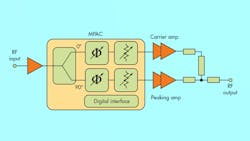Monolithic RF Chip Optimises Doherty Amplifier Performance
Peregrine Semiconductor’s line of UltraCMOS Monolithic Phase & Amplitude Controllers (MPACs) offers a monolithic RF solution to maximize Doherty amplifier performance. Through a digital interface, MPACs enable alignment of the phase and amplitude between the Doherty amplifier’s carrier and peaking paths.
While widely used in the wireless infrastructure industry, Doherty amplifiers require a considerable engineering investment to manually implement and optimize. Any mismatch or misalignment in phase and amplitude between the Doherty architecture’s carrier and peaking paths can quickly increase costs and degrade the system’s overall performance. Even after optimizing with discrete components, the system remains inflexible to manufacturing variances from power amplifier assemblies.
The MPACs solve this challenge by maximising asymmetric and symmetric Doherty amplifier performance. The devices integrate Peregrine’s digital step attenuators and phase shifter products onto a single die. Each chip includes a 90° hybrid splitter, two phase shifters, two amplitude controllers, and a digital serial peripheral interface (SPI).
With a wide positive and negative phase shift range and a fine step size, each MPAC delivers high linearity of 65-dBm third-order intermodulation intercept point (IIP3) and extremely low power consumption of 300 µA. It provides performance advantages in power handling and port-to-port isolation.
Also, Peregrine’s UltraCMOS technology enables superior electrostatic discharge (ESD) performance of 1 kV, an extended temperature range up to 105°C, and a wide power supply range from 2.7 to 5.5 V. The first product in the MPAC family, the PE46120, covers a frequency range of 1.8 to 2.2 GHz.
About the Author
Staff
Articles, galleries, and recent work by members of Electronic Design's editorial staff.
